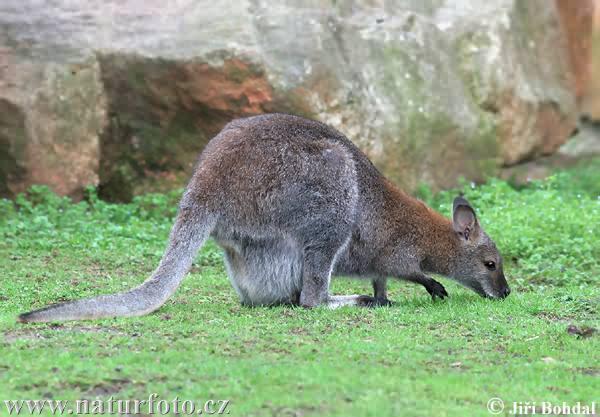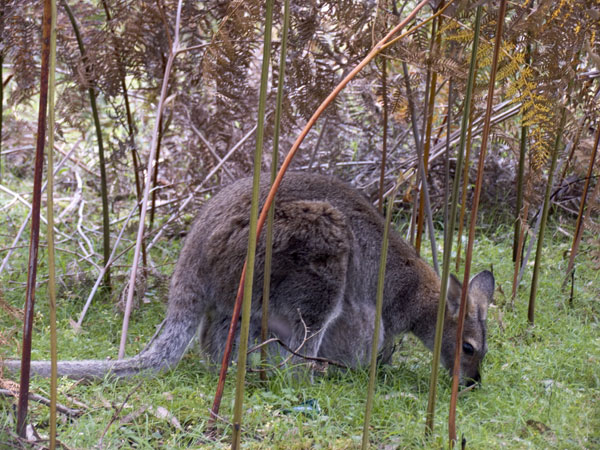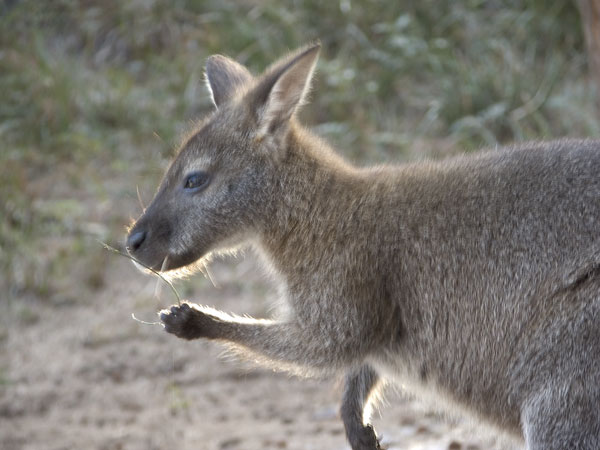 Macropus
rufogriseus
Macropus
rufogriseusRed-Necked Wallaby

 :: Nutrition
:: Nutrition
What does the Red-necked Wallaby eat
and how does digestion work?
The Red-necked Wallaby is a herbivore, meaning it eats only plants. It eats mostly grasses, spear grass, and shrubs. They also consume hay, bark, leaves, vegetables and fruits. When it is dry they eat juicy roots of plants for the water. They feet in open areas that are close to the forest so they are close to shelter. The Red-necked Wallaby is nocturnal, and feeds late in the afternoon and evening, or very early in the morning.

Now that we know what they eat, lets look at how it eats. First, there are three important muscles in the jaw and temple that helps the wallaby bite and chew. These muscles are the temporals, masseter, and pterygoid. As the wallaby opens its mouth to grasp food the lower jaw moves forward, compared to the upper jaw. Due to contractions of the pterygoid muscle the lower incisors separate, this allows the lower incisors to rub against the upper incisors. This grasps the food it is about to eat rather then cuts it. When the grass or shrubs are free the jaw is moved back and the lower incisors move back together due to contraction of the masseter and temporals muscle. Once the food is grasped, the lips and tongue are used to push the food to the row of molars. Here it is chewed with a side to side movement as the lower molars rub across the upper ones.
The Red-necked Wallaby has a very large parotid salivary gland, which produces copious saliva. This saliva has
high concentration of Sodium and Bicarbonate ions. These
ions act as a buffer to the fluid with alkaline pHs. The
food is then passed into the stomach. They have a very
large stomach that looks like and elongated bag. In the forestomach the food is broken down by bacterial
fermentation and volatile fatty acids. The food is
stored as glucose and used for energy. They have a high
resting value of glucose which leads to a fast rate of
food passing through the stomach. Because it passes so
quickly the bacteria is not allowed to completely break
down the cellulose. The fast passage and decreased break
down of food in the end leads to more food and more
nutrients that can maintain a positive energy balance.
This means that they can take in a low food intake with
a lower grade food. One down fall of this lower grade
and minimal food intake is slower then normal growth.
produces copious saliva. This saliva has
high concentration of Sodium and Bicarbonate ions. These
ions act as a buffer to the fluid with alkaline pHs. The
food is then passed into the stomach. They have a very
large stomach that looks like and elongated bag. In the forestomach the food is broken down by bacterial
fermentation and volatile fatty acids. The food is
stored as glucose and used for energy. They have a high
resting value of glucose which leads to a fast rate of
food passing through the stomach. Because it passes so
quickly the bacteria is not allowed to completely break
down the cellulose. The fast passage and decreased break
down of food in the end leads to more food and more
nutrients that can maintain a positive energy balance.
This means that they can take in a low food intake with
a lower grade food. One down fall of this lower grade
and minimal food intake is slower then normal growth.

Another important point of their digestive system is urea production. Urea is from the parotid saliva and is added to the forestomach. It is reabsorbed in the kidneys of wallabies that have low nitrogen. (Nitrogen is needed in protein synthesis.) When the urea is stored in the kidneys it is saving water. This is an important adaption because in the living condition of the wallabies there can often be water shortage or poor vegetation. This way they do not need a large amount of water.
Learn about their reproduction!!!
The Red-necked Wallaby is a herbivore, meaning it eats only plants. It eats mostly grasses, spear grass, and shrubs. They also consume hay, bark, leaves, vegetables and fruits. When it is dry they eat juicy roots of plants for the water. They feet in open areas that are close to the forest so they are close to shelter. The Red-necked Wallaby is nocturnal, and feeds late in the afternoon and evening, or very early in the morning.

Now that we know what they eat, lets look at how it eats. First, there are three important muscles in the jaw and temple that helps the wallaby bite and chew. These muscles are the temporals, masseter, and pterygoid. As the wallaby opens its mouth to grasp food the lower jaw moves forward, compared to the upper jaw. Due to contractions of the pterygoid muscle the lower incisors separate, this allows the lower incisors to rub against the upper incisors. This grasps the food it is about to eat rather then cuts it. When the grass or shrubs are free the jaw is moved back and the lower incisors move back together due to contraction of the masseter and temporals muscle. Once the food is grasped, the lips and tongue are used to push the food to the row of molars. Here it is chewed with a side to side movement as the lower molars rub across the upper ones.
The Red-necked Wallaby has a very large parotid salivary gland, which
 produces copious saliva. This saliva has
high concentration of Sodium and Bicarbonate ions. These
ions act as a buffer to the fluid with alkaline pHs. The
food is then passed into the stomach. They have a very
large stomach that looks like and elongated bag. In the forestomach the food is broken down by bacterial
fermentation and volatile fatty acids. The food is
stored as glucose and used for energy. They have a high
resting value of glucose which leads to a fast rate of
food passing through the stomach. Because it passes so
quickly the bacteria is not allowed to completely break
down the cellulose. The fast passage and decreased break
down of food in the end leads to more food and more
nutrients that can maintain a positive energy balance.
This means that they can take in a low food intake with
a lower grade food. One down fall of this lower grade
and minimal food intake is slower then normal growth.
produces copious saliva. This saliva has
high concentration of Sodium and Bicarbonate ions. These
ions act as a buffer to the fluid with alkaline pHs. The
food is then passed into the stomach. They have a very
large stomach that looks like and elongated bag. In the forestomach the food is broken down by bacterial
fermentation and volatile fatty acids. The food is
stored as glucose and used for energy. They have a high
resting value of glucose which leads to a fast rate of
food passing through the stomach. Because it passes so
quickly the bacteria is not allowed to completely break
down the cellulose. The fast passage and decreased break
down of food in the end leads to more food and more
nutrients that can maintain a positive energy balance.
This means that they can take in a low food intake with
a lower grade food. One down fall of this lower grade
and minimal food intake is slower then normal growth. 
Another important point of their digestive system is urea production. Urea is from the parotid saliva and is added to the forestomach. It is reabsorbed in the kidneys of wallabies that have low nitrogen. (Nitrogen is needed in protein synthesis.) When the urea is stored in the kidneys it is saving water. This is an important adaption because in the living condition of the wallabies there can often be water shortage or poor vegetation. This way they do not need a large amount of water.
Learn about their reproduction!!!





